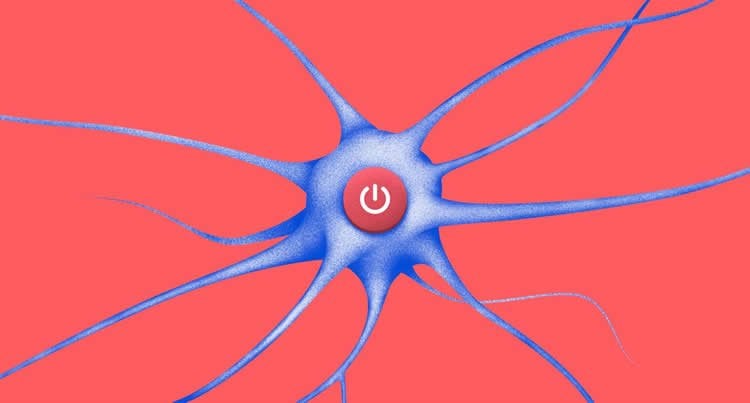Summary: Researchers report the NsXeR protein can activate individual neurons when exposed to light.
Source: MIPT.
Scientists have examined a protein that will find application in optogenetics and could be used to control muscle and neuronal cells. The paper on the light-sensitive NsXeR protein of the xenorhodopsin class was published in Science Advances by the international team of researchers from MIPT, Forschungszentrum Jülich, and Institut de Biologie Structurale.
Why it matters
Optogenetics is a new technique that uses light to control neurons or muscle cells in living tissue. It has found wide application in nervous system studies. Optogenetic manipulations are so precise that they make it possible to control individual neurons by switching certain information transfer pathways on or off. Similar methods are also used to partially reverse eyesight or hearing loss as well as to control muscle contractions.
The main tools of optogenetics are light-sensitive proteins that are intentionally inserted into particular cells. After the insertion, the protein becomes attached to the cell surface and moves ions across the membrane upon exposure to light. Thus, in a modified neuron cell, a correctly chosen light impulse may activate a neural signal or, on the contrary, suppress all the signals, depending on which protein is used. By activating signals from individual neurons, it is possible to imitate the functioning of certain brain regions — a technique that modulates the behavior of the organism under study. If such proteins are inserted in muscle cells, an external signal can tense or relax them.
The authors of the paper, which was published in Science Advances, described a new optogenetic tool — a protein called NsXeR, which belongs to the class of xenorhodopsins. When exposed to light, it can activate individual neurons, making them send set signals to the nervous system. Apart from applications in nervous system research, xenorhodopsins may also take over muscle cell control. To activate these cells, it is preferable that calcium ion transport be blocked, because alterations in the ion concentration can affect them. When using proteins that transport various positive ions (such as calcium) nonselectively, undesirable side effects are likely to appear.

The discovered protein helps to bypass uncontrolled calcium translocation: It is selective and pumps nothing but the protons into the cell. Because of this selectivity, it has a considerable advantage over its chief rival channelrhodopsin, which is being extensively used in research but does not discriminate between positively charged ions. What is more, xenorhodopsin acts as a reliable pump, transporting protons both into and out of the cell regardless of their concentration, whereas channelrhodopsin only allows ions to move from an area of higher concentration to an area of lower concentration. In both cases a positive charge inflow into an excitable cell reduces the tension between its inner and outer membrane surfaces. Such membrane depolarization generates a nerve or muscle impulse. The ability to induce such an impulse by pumping nothing but protons will reduce possible side effects during research.
“So far we have all the necessary data on how the protein functions. This will become the basis of our further research aimed at optimizing and adjusting the protein parameters to the needs of optogenetics,” says Vitaly Shevchenko, the lead author of the paper and a staff member at the MIPT Laboratory for Advanced Studies of Membrane Proteins.
Funding: This research was supported ERA.Net RUS PLUS and the Ministry of Education and Science of the Russian Federation (project ID 323, RFMEFI58715X0011).
Source: Asya Shepunova – MIPT
Image Source: NeuroscienceNews.com image is credited to MIPT Press Office.
Original Research: Full open access research for “Inward H+ pump xenorhodopsin: Mechanism and alternative optogenetic approach” by Vitaly Shevchenko, Thomas Mager, Kirill Kovalev, Vitaly Polovinkin, Alexey Alekseev, Josephine Juettner, Igor Chizhov, Christian Bamann, Charlotte Vavourakis, Rohit Ghai, Ivan Gushchin, Valentin Borshchevskiy, Andrey Rogachev, Igor Melnikov, Alexander Popov, Taras Balandin, Francisco Rodriguez-Valera, Dietmar J. Manstein, Georg Bueldt, Ernst Bamberg and Valentin Gordeliy in Science Advances. Published online September 22 2017 doi:10.111263/sciadv.1603187
[cbtabs][cbtab title=”MLA”]MIPT “New Proton ‘Starter’ for Optogenetics.” NeuroscienceNews. NeuroscienceNews, 29 September 2017.
<https://neurosciencenews.com/optogenetics-proton-starter-7620/>.[/cbtab][cbtab title=”APA”]MIPT (2017, September 29). New Proton ‘Starter’ for Optogenetics. NeuroscienceNews. Retrieved September 29, 2017 from https://neurosciencenews.com/optogenetics-proton-starter-7620/[/cbtab][cbtab title=”Chicago”]MIPT “New Proton ‘Starter’ for Optogenetics.” https://neurosciencenews.com/optogenetics-proton-starter-7620/ (accessed September 29, 2017).[/cbtab][/cbtabs]
Abstract
Inward H+ pump xenorhodopsin: Mechanism and alternative optogenetic approach
Generation of an electrochemical proton gradient is the first step of cell bioenergetics. In prokaryotes, the gradient is created by outward membrane protein proton pumps. Inward plasma membrane native proton pumps are yet unknown. We describe comprehensive functional studies of the representatives of the yet noncharacterized xenorhodopsins from Nanohaloarchaea family of microbial rhodopsins. They are inward proton pumps as we demonstrate in model membrane systems, Escherichia coli cells, human embryonic kidney cells, neuroblastoma cells, and rat hippocampal neuronal cells. We also solved the structure of a xenorhodopsin from the nanohalosarchaeon Nanosalina (NsXeR) and suggest a mechanism of inward proton pumping. We demonstrate that the NsXeR is a powerful pump, which is able to elicit action potentials in rat hippocampal neuronal cells up to their maximal intrinsic firing frequency. Hence, inwardly directed proton pumps are suitable for light-induced remote control of neurons, and they are an alternative to the well-known cation-selective channelrhodopsins.
“Inward H+ pump xenorhodopsin: Mechanism and alternative optogenetic approach” by Vitaly Shevchenko, Thomas Mager, Kirill Kovalev, Vitaly Polovinkin, Alexey Alekseev, Josephine Juettner, Igor Chizhov, Christian Bamann, Charlotte Vavourakis, Rohit Ghai, Ivan Gushchin, Valentin Borshchevskiy, Andrey Rogachev, Igor Melnikov, Alexander Popov, Taras Balandin, Francisco Rodriguez-Valera, Dietmar J. Manstein, Georg Bueldt, Ernst Bamberg and Valentin Gordeliy in Science Advances. Published online September 22 2017 doi:10.111263/sciadv.1603187






